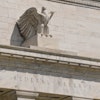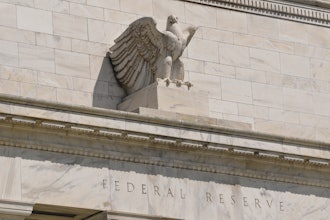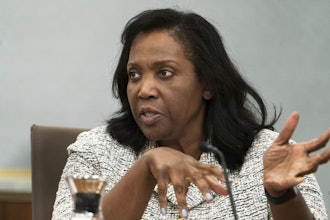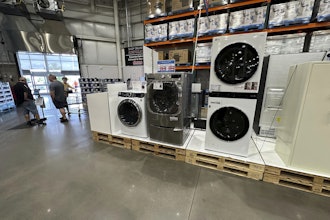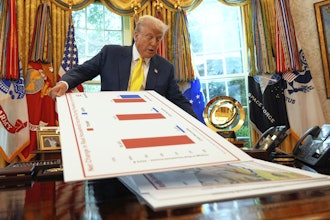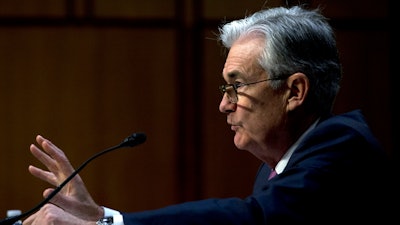
WASHINGTON (AP) — The Federal Reserve kept its key interest rate unchanged at a low level Wednesday amid an economy that looks solid but faces potential global threats, including from China’s viral outbreak.
The Fed sketched a mostly bright picture of the U.S. economy in a statement it released after its latest policy meeting. Yet it also cautioned that it would monitor the world economy, which could be slowed by China’s coronavirus — a risk that Chairman Jerome Powell mentioned at the start of a news conference. Stock and bond markets have gyrated in the past week over fears about the virus.
The central bank said it would hold short-term rates in a range of 1.5% to 1.75%, far below levels that were typical during previous expansions. Powell and other Fed officials have indicated that they see that range as low enough to support faster growth and hiring.
Stock prices slipped after the Fed issued its statement at 2 p.m. Eastern time and Powell began his news conference 30 minutes later. The Dow Jones Industrial Average closed barely higher after having posted stronger gains in earlier trading. Bond yields declined slightly.
The Fed’s statement, which its policymaking committee approved 10-0, was nearly identical to the one it issued in December, though this time it described consumer spending as rising at only a “moderate” rather than at a “strong” pace. That change likely reflects relatively modest spending by Americans over the holiday shopping season.
Last year, the Fed cut its benchmark rate three times after having raised it four times in 2018. Powell and other Fed officials credit those rate cuts with revitalizing the housing market, which had stumbled early last year, and offsetting some of the drag from President Donald Trump’s trade war with China.
But China’s viral outbreak has injected fresh doubts into that outlook. The coronavirus has in effect shut down much of that nation and seems sure to slow the Chinese economy — the world’s second-largest — which had already been decelerating. The virus has now infected more people in China than were sickened in the country by the SARS outbreak in 2002-2003.
In his news conference, Powell said there have been encouraging signs that the global economy would pick up this year — until the coronavirus struck. The preliminary U.S.-China trade deal, the resolution of Brexit and low rates in the United States and abroad suggested that the world economy would expand more quickly. But Powell called the coronavirus a "very serious issue,” though he noted that it’s too early to tell how damaging it will be.
"It's very uncertain about how far it will spread and what the (economic) effects will be in China, for its trading partners, and around the world,” the chairman said.
At the same time, Powell suggested that “there are signs and reasons to expect” a global economic rebound.
Major companies across the world have responded to the virus by suspending some operations in China. Starbucks said it plans to close half its stores in China, its second-largest market. British Airways has halted all flights to China, and American Airlines suspended Los Angeles flights to and from Shanghai and Beijing.
Hotels, airlines, casinos and cruise operators are among the industries that have suffered the most immediate repercussions. Apple CEO Tim Cook said the company’s suppliers in China have been forced to delay the re-opening of factories that have closed for the Chinese New Year holiday until Feb. 10.
Investors seem increasingly to believe that the Fed will feel compelled to cut rates again later this year. The chances of a cut by September’s Fed meeting have risen above 70%, according to the Chicago Mercantile Exchange’s FedWatch tool, up from roughly 40% just a month ago.
Still, Paul Ashworth, chief U.S. economist at Capital Economics, said he saw nothing in the Fed’s statement or at Powell’s news conference to make him change his belief that the central bank will keep its benchmark rate unchanged for the foreseeable future.
“Unless the U.S. experiences its own epidemic (from the coronavirus), we doubt that the indirect effects from the disruptions in China would be enough to warrant a U.S. rate cut,” Ashworth said.
On another topic, Powell said the Fed will continue its purchases of six-month Treasury bills to ensure that short-term lending markets operate smoothly. The Fed began buying $60 billion of the bills each month in October to expand cash reserves that are available for overnight lending, after a shortage of reserves caused overnight rates to spike. The lending squeeze also pushed the Fed’s benchmark rate out of its target range.
The Fed plans to continue its purchases until the second quarter, Powell said, while it slowly draws down some temporary lending it has also done to boost short-term lending markets.
Powell said the overall economy, not just Wall Street, has benefited from the Fed’s bond-buying because it’s enabled the Fed’s low-rate policy to reduce mortgage rates and other consumer borrowing costs.
“That really is important for the public,” Powell said.
The Fed’s decision came a day after Trump, in a tweet, again pressed Powell to cut rates, arguing that this would make U.S. interest rates “competitive with other Countries.” Yet the Fed hopes to avoid the ultra-low and negative interest rates that exist in much of Europe and in Japan, which they — and most analysts — see as evidence of weak economies.
Most analysts think the Fed would be more willing to cut rates if there were clear signs of a sharp economic slowdown. Still, some Fed watchers say they foresee a rate cut by summer or after November's elections.
One reason for a potential future cut is that inflation remains chronically low. According to the Fed's preferred inflation gauge, prices rose just 1.5% in November from a year earlier, below the central bank's 2% annual target. Since the Fed adopted that target in 2012, inflation has failed to consistently reach that high, to the surprise of the Fed and most economists.


